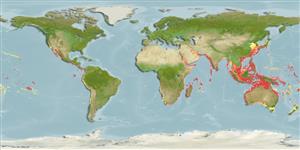Teleostei (teleosts) >
Tetraodontiformes (Puffers and filefishes) >
Tetraodontidae (Puffers) > Tetraodontinae
Etymology: Lagocephalus: Greek, lagos = hare + Greek, kephale = head (Ref. 45335).
More on author: Gmelin.
Environment: milieu / climate zone / depth range / distribution range
Ecology
Marine; reef-associated; depth range 18 - 100 m (Ref. 11441). Tropical; 40°N - 40°S, 16°E - 124°W
Indo-West Pacific (Ref. 4919). Lessepsian migrant to the Mediterranean Sea (Ref. 55043).
Length at first maturity / Size / Weight / Age
Maturity: Lm 43.3 range ? - ? cm
Max length : 110 cm TL male/unsexed; (Ref. 125962); common length : 40.0 cm TL male/unsexed; (Ref. 5450); max. published weight: 9.0 kg (Ref. 125962)
Inhabits offshore reefs (Ref. 9563). Sandy bottom (Ref. 95646). Caught by trammel net (Ref. 96695). This species contains tetrodotoxin which may be a source for food poisoning and the Israel Poison Information center registered 13 cases in December 2008 where all were related to the consumption of this fish (Ref. 118670).
Life cycle and mating behavior
Maturities | Reproduction | Spawnings | Egg(s) | Fecundities | Larvae
Masuda, H., K. Amaoka, C. Araga, T. Uyeno and T. Yoshino, 1984. The fishes of the Japanese Archipelago. Vol. 1. Tokai University Press, Tokyo, Japan. 437 p. (text). (Ref. 559)
IUCN Red List Status (Ref. 130435)
Threat to humans
Poisonous to eat (Ref. 559)
Human uses
Fisheries: of no interest; aquarium: commercial
Tools
Special reports
Download XML
Internet sources
Estimates based on models
Preferred temperature (Ref.
123201): 21.6 - 28.6, mean 27.3 °C (based on 762 cells).
Phylogenetic diversity index (Ref.
82804): PD
50 = 0.5005 [Uniqueness, from 0.5 = low to 2.0 = high].
Bayesian length-weight: a=0.01349 (0.01114 - 0.01633), b=2.87 (2.81 - 2.93), in cm total length, based on LWR estimates for this species (Ref.
93245).
Trophic level (Ref.
69278): 3.7 ±0.4 se; based on diet studies.
Resilience (Ref.
120179): Medium, minimum population doubling time 1.4 - 4.4 years (tmax=7; tm=3; K=0.099-0.3;).
Fishing Vulnerability (Ref.
59153): Moderate vulnerability (40 of 100).
Nutrients (Ref.
124155): Calcium = 18.1 [7.7, 40.9] mg/100g; Iron = 0.452 [0.237, 0.911] mg/100g; Protein = 18.9 [16.7, 21.1] %; Omega3 = 0.128 [0.060, 0.249] g/100g; Selenium = 50.1 [26.9, 98.3] μg/100g; VitaminA = 53.4 [20.0, 144.7] μg/100g; Zinc = 0.9 [0.6, 1.3] mg/100g (wet weight);
